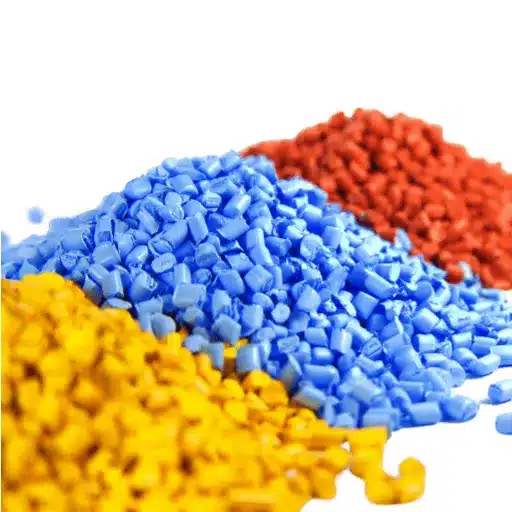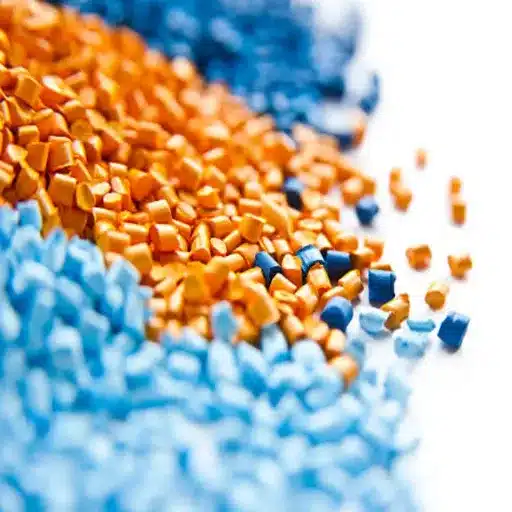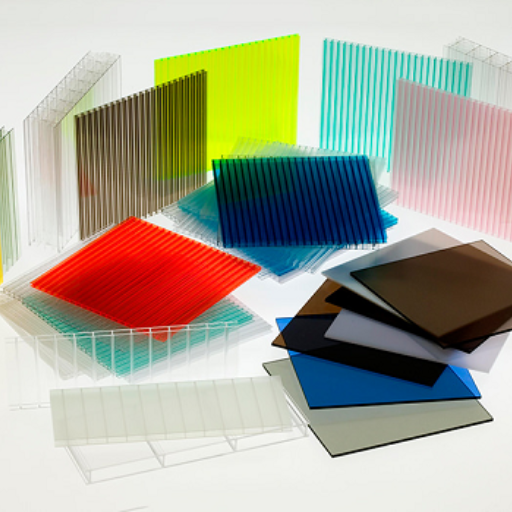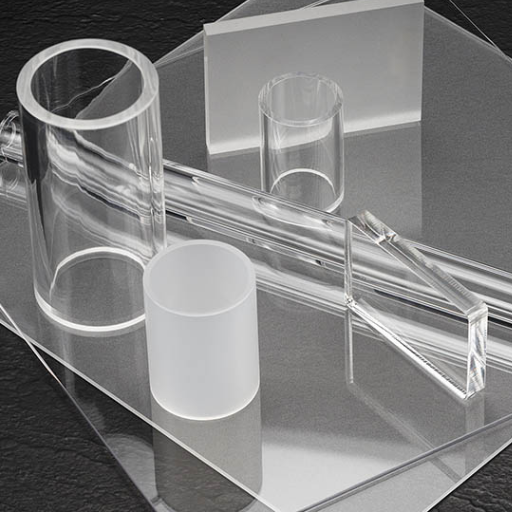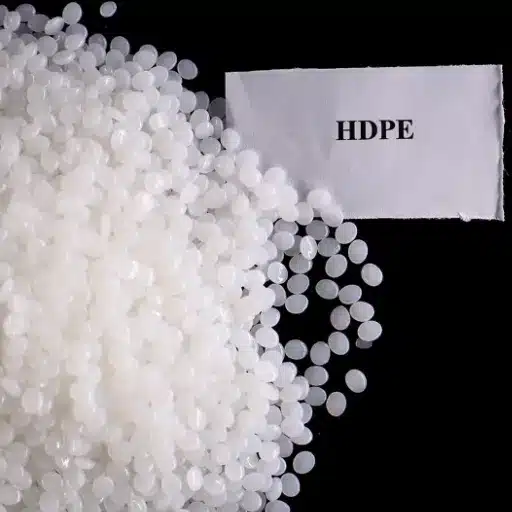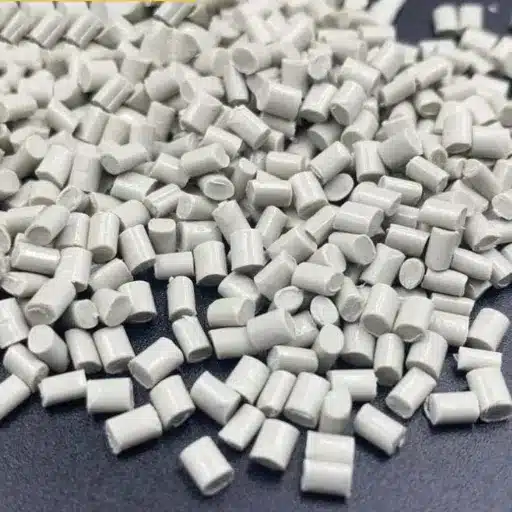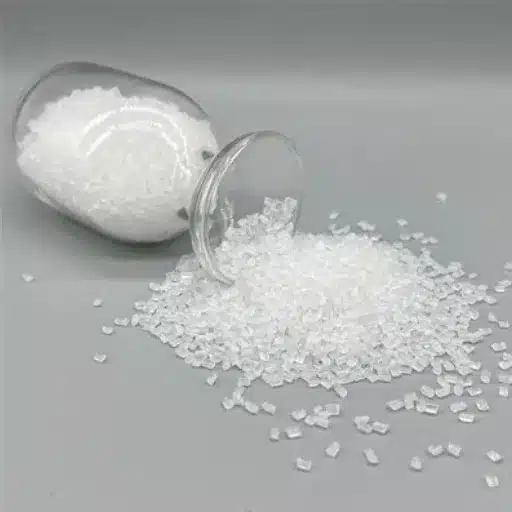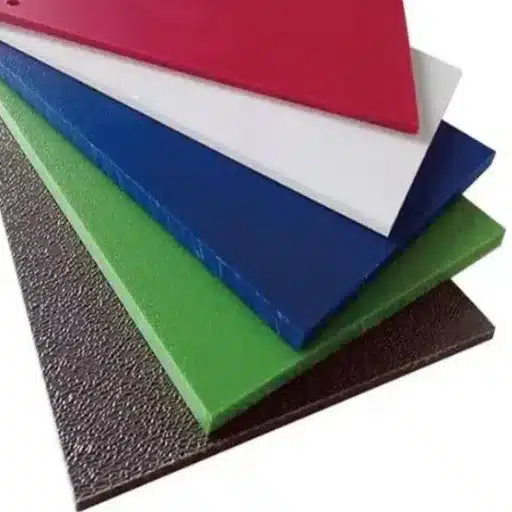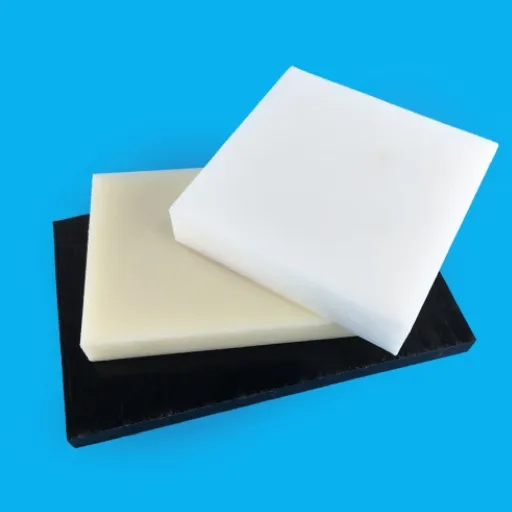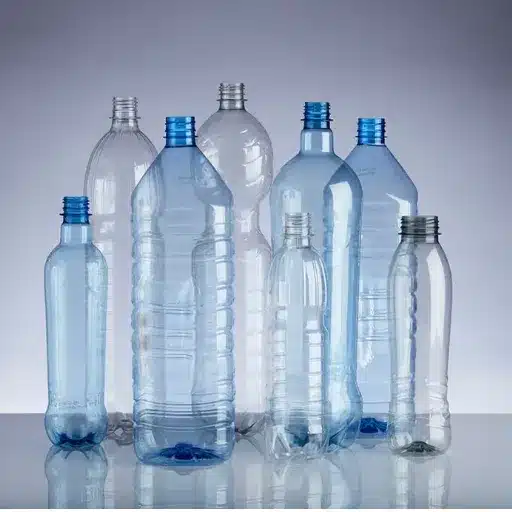The text field on pom-materialHigh-density polyethylene (HDPE) is a plastic material that is among the most versatile and utilitarian in the modern world. Not only can it be found in everyday items such as water bottles and food containers, but it is also an essential part of the industry with applications like piping and geomembranes. Its strong points such as being light weight, resistant to impact and chemicals, and durability have made it a material that both consumers and manufacturers prefer. Nevertheless, what are the features that make HDPE different from other plastics and why has it become so essential? The article delineates the main characteristics, advantages, and diverse uses of HDPE and is, therefore, a source of enlightenment as to why this powerful material is still the one that drives innovation in the world. It doesn’t matter to which group you belong: a business leader, engineer, or a person simply curious about sustainability, this voyage through HDPE will deepen your understanding of its remarkable potential and significance.
Introduction to HDPE

What is HDPE?
HDPE, which stands for High-Density Polyethylene, is a very durable and versatile thermoplastic polymer that is known widely for its high strength-to-density ratio. It is produced from petroleum and is one of the most widely used types of plastic, mainly for its impact, moisture, and chemical resistance. HDPE is a lightweight material but still very strong, thus it is used for applications such as packaging materials, piping systems, construction components, etc. further, HDPE is also being extensively recycled which in turn increases its importance as an eco-friendly option due to the ease of recycling and its further use in making more products in the future. Besides, the production of HDPE can be done in many ways and the material retains its properties which makes it very much adaptable for use in various sectors and hence its prominence is ensured.
History and Development of HDPE Plastic
High-Density Polyethylene (HDPE) was first discovered in 1953 by Karl Ziegler, a German chemist, together with his assistant Erhard Holzkamp, at Max Planck Institute. Their success was obtained during the investigation of catalysts, which led to the introduction of a low-pressure polymerization process—commonly referred to as the Ziegler process— that completely changed the production of plastics. Soon after, in the year 1955, production of HDPE began which was a major step forward for industrial applications.
Key Historical Milestone: Throughout the years, the technologies applied to the processing of polymers have gradually the quality of HDPE, making it more economical and giving it a wider range of applications. Nowadays, the focus of the processes for the production of HDPE is on the sustainability of the process. The recent reports indicate that the production of HDPE in the world is increasing and the market size in 2023 is estimated to be about $70 billion with the industries using more of the plastic that is lightweight, strong, and recyclable as the main factor driving the growth. The turning point for HDPE from a scientific marvel to commonplace use in our daily lives, the whole journey bears testimony to the trade between innovation and demand in the industry.
Importance of HDPE in Modern Manufacturing
High-Density Polyethylene (HDPE) is an essential material for modern manufacturing because of its adaptability, strength, and reusability. The latest statistics show that the packaging, automotive, and construction sectors are the main users of HDPE, who value its properties that allow for the production of materials that are both light and strong. According to search trends, there is an increasing fascination with green materials; the use of HDPE is frequently acknowledged for being eco-friendly when disposed of in the right manner. The recyclability of the material leads to less waste and it is actively promoting models like the circular economy that is in line with the global measures taken to lessen the impact on the environment. With the consumer trend going towards green products, manufacturers are relying more on HDPE not only because of its performance but also to help them achieve their sustainability goals.
Material Properties of HDPE Plastic

Chemical Resistance and Durability
High-Density Polyethylene (HDPE), is one of the most chemical resistant and durable plastics available, thus, it is suitable for even toughest environments and applications ranging from industrial to consumer products. Besides, it is still very difficult to decompose or corrode HDPE products painted with a protection coat even if they have been in contact with extremely nasty chemicals including acids, alkalis, and solvents, thus incomparable performance in the chemical-exposed areas like pipelines, containers and industrial tanks where such events are likely to happen.
Key Durability Features:
- High strength-to-density ratio enables impact resistance
- Withstands extreme temperature changes without losing utility
- Reduces replacement frequency and waste generation
- Combines performance with environmental consciousness
Mechanical Properties of HDPE Sheets
The list of mechanical properties of High-Density Polyethylene (HDPE) is quite impressive which is one of the reasons why it has become a top material across many industries. For instance, HDPE sheets have very high tensile strength that ranges from 3,000 to 4,000 psi and thus are very strong and can easily withstand the pulling force and even more without losing their shape. Their elongation at break, which is generally above 500%, indicates that the material has great flexibility and can endure stress that would otherwise lead to a crack without breaking the material.
| Property | Value/Range | Significance |
|---|---|---|
| Tensile Strength | 3,000 – 4,000 psi | High resistance to pulling forces |
| Elongation at Break | Above 500% | Excellent flexibility and stress resistance |
| Friction Coefficient | Low | Smooth operation in sliding applications |
| Impact Resistance | Excellent (room temp to sub-zero) | Suitable for tough operating conditions |
| Hardness (Shore D Scale) | ~60 | Optimal balance of durability and flexibility |
Another property that is worth mentioning is the low friction coefficient which is the reason for the smooth running of the applications that are using sliding surfaces or machinery. Moreover, the plastic has excellent impact resistance not only at room temperature but also at sub-zero degrees which is why it is recommended for very tough operating conditions. Besides, the hardness rating of around 60 on the Shore D Scale, places the materials in a category of matrix that is neither too soft nor too hard, it is just right when it comes to durability and strength. All these mechanical advantages become even more compelling when one factors in the chemical resistance and lightness of HDPE as a material so it is indeed a super material both for industrial and daily use.
Thermal Properties and Processing Temperatures
The thermal properties of high-density polyethylene (HDPE) are excellent, and that is why it is a reliable material for many different applications. The melting point of HDPE is usually between 120°C and 130°C (248°F to 266°F) which is depending on its exact composition. This melting point range is like a buffer zone since it allows HDPE to keep its original shape under moderate heat without going through the melting process. In addition, if HDPE is the material of choice, it can handle high temperatures of about 80°C (176°F) continuously in some of its uses before one can notice some of its performance degradation.
Processing Temperature Guidelines:
- Melting Point: 120°C – 130°C (248°F – 266°F)
- Continuous Use Temperature: Up to 80°C (176°F)
- Processing Temperature (Molding/Extrusion): 160°C – 250°C (320°F – 482°F)
Molding and extrusion are the two main ways for processing HDPE, and usually, the temperatures used range from 160°C to 250°C (320°F to 482°F), thus, the flow properties will be the best and quality will be guaranteed in the end products. The high level of crystallinity is the main factor that contributes to its thermal stability through which it can endure the tough heat demanding fabrication processes. These factors make HDPE an outstanding candidate for the industries such as piping, car manufacturing, and storage solutions that need thermal durability.
Industrial Applications of HDPE
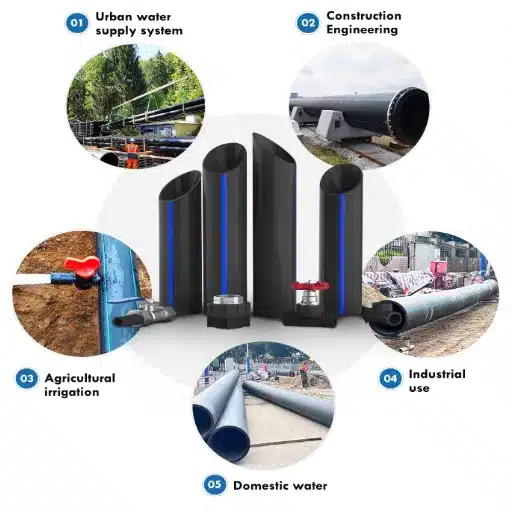
Use of HDPE in Packaging Solutions
High-Density Polyethylene (HDPE) is a material that is mainly used in modern packaging due to its various properties such as being strong, light, and cheap. The most common uses are in milk jugs, detergent bottles, and food containers where the safe storing and transporting of goods is ensured due to the material’s great resistance to impacts and chemicals. Recent studies have shown that the worldwide consumption of HDPE in the packing sector will increase dramatically, and the main reasons for this are its recyclability and its ability to meet the sustainability goals. What is more, new technologies in manufacturing are helping in producing thinner, more efficient HDPE packaging that is using less material but still having the same strength and functionality. Such advantages have made HDPE not only a reliable but also a preferred material in consumer and industrial packaging solutions.
Construction and Infrastructure Applications
High-Density Polyethylene (HDPE) is a material that positively influences construction and infrastructure projects because it is durable, versatile, and cost-wise suitable. It is mainly used in the piping systems, geomembrane landfills, and cable insulation applications. The resistance to corrosion and chemical damage makes HDPE the material of choice for water and gas supply systems, even in the most difficult environments. A recent study on Trends indicates a significant increase in searches related to “HDPE pipes for construction” and “HDPE in infrastructure projects” that is showing a growing interest and adoption in these areas. This increase is in line with the expansion of global construction activities and the emphasis on sustainable materials, thus making HDPE an essential resource in the day-to-day infrastructure development.
Primary Construction Applications:
- Piping Systems: Water and gas distribution networks
- Geomembrane Landfills: Environmental containment solutions
- Cable Insulation: Protection for electrical infrastructure
HDPE in the Automotive Industry
HDPE (High-Density Polyethylene) has become a material that is indispensable to the automotive industry because of its durability, light weight, and versatility. It is often used for fuel tanks, interior panels, bumpers, and other parts, thus helping to cut down vehicle weight, consequently improving fuel efficiency and reducing emissions. The latest search engine data has revealed an outstanding rise in the number of searches on “HDPE applications in automotive manufacturing” and “lightweight materials for vehicles,” which is a sign of the increasing demand for sustainable and cost-effective automotive solutions. The automobile industry is moving towards the use of HDPE as an ideal mix of performance and sustainability in modern car design in its efforts to optimize production methods and comply with environmental regulations.
Environmental Considerations of HDPE Plastic

Recyclability of High-Density Polyethylene
High-Density Polyethylene (HDPE) is often citied as the most recyclable plastic with the least environmental impact. The recent statistics state that HDPE only gets recycled at a rate of around 30% in the US which is nevertheless much more than the corresponding figures for most other plastics. Its simple structure of polymers allows melting and reshaping into new products without deterioration of quality many times during the life process.
Recycled HDPE Applications:
- Car parts
- Pipes
- Plastic bottles
- Construction materials
In recycling, HDPE is mostly turned into raw materials for new products such as car parts, pipes, plastic bottles, and even construction material. The closed recycling loop minimizes the use of new resin, Saves natural resources, and reduces the total energy intake for production. Besides, the sorting and cleaning technology improvements continue to give a significant boost to the recycling efficiency and scale thereby establishing HDPE as the most important plastic in the circular economy strategy.
Impact of HDPE on the Environment
High-density polyethylene (HDPE) is both an essential substance and a major concern regarding the environment. Durable and versatile HDPE does not become a problem if properly managed but otherwise leads to increased plastic pollution in the case of large-scale usage which is very common. The latest figures disclose that HDPE represents a considerable part of the global plastic market with tens of millions of tons produced every year. Non-recycling of HDPE products is one of the factors contributing to land and sea pollution where plastics are sometimes forced to wait hundreds of years to get broken down which is obviously harmful to ecosystems and animals.
However, the good side lies in the fact that technology developments in recycling have correspondingly increased the capacity to nullify the negative impact of HDPE on the environment. Recycling of HDPE produces much lower greenhouse gas emissions than virgin plastic production, and the material’s recycling capacity contributes to the establishment of a circular economy. Public education and regulatory measures are bringing more sustainability practices such as collection systems enhancements and consumer uptake in recycling that are indispensable to the environment impact mitigation of HDPE.
Innovations in Sustainable HDPE Production
Technological progress in recent times has made it possible to produce HDPE in a more sustainable manner with less environmental damage and more efficiency. One of the notable achievements is the invention of plant-based or bio-based HDPE which is made from sugarcane or other agricultural products and hence it does not depend on fossil resources. At the same time, chemical recycling processes like pyrolysis and depolymerization come to the fore in the market. They convert waste HDPE to its basic monomers, thus producing high-quality plastics of recycled content that can compete with the performance of virgin materials.
Cutting-Edge Sustainability Innovations:
- Bio-based HDPE: Produced from sugarcane and agricultural products
- Chemical Recycling: Pyrolysis and depolymerization techniques
- AI-Powered Recycling: Machine learning for improved sorting and separation
- Energy-Efficient Production: Low-pressure techniques and renewable energy sources
A promising trend is incorporating machine learning and AI-based systems to facilitate the recycling process. These techniques will quickly and accurately find and separate HDPE hence cutting down the contamination and raising the recycling rate. Besides, manufacturers are improving the technology by reducing energy and emissions from the production process in the case of HDPE. For example, the implementation of low-pressure techniques and the use of renewable energy sources are helping to create a more eco-friendly manufacturing cycle.
Comparing HDPE with Other Plastics
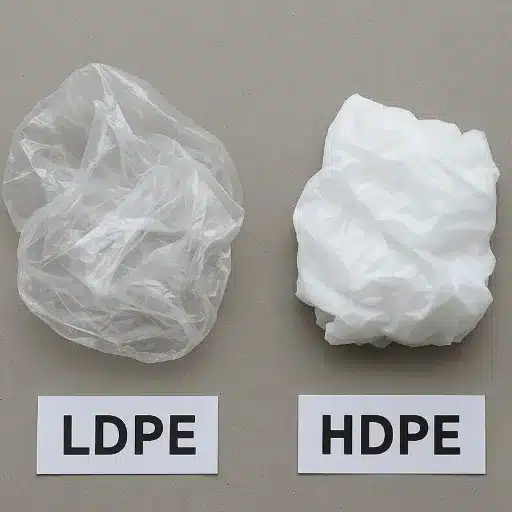
HDPE vs. LDPE: Key Differences
The primary distinction between high-density polyethylene (HDPE) and low-density polyethylene (LDPE) is their structure and specific use. HDPE features a linear molecular structure that leads to the characteristics of density, strength, and rigidity; these properties make it the right option for non-invasive products like containers, pipes, and heavy-duty plastic packaging. Conversely, LDPE, with its branched molecular structure, has lower density and increased flexibility, making it more suitable for plastic bags, film wraps, and squeeze bottles.
| Characteristic | HDPE | LDPE |
|---|---|---|
| Molecular Structure | Linear | Branched |
| Density | High | Low |
| Strength & Rigidity | Superior strength and rigidity | More flexible |
| Common Applications | Containers, pipes, heavy-duty packaging | Plastic bags, film wraps, squeeze bottles |
| Recyclability | Highly recyclable with better reuse potential | Recyclable but faces more challenges |
In accordance with the most recent data from search engine, HDPE is gradually winning preference among eco-friendly applications due to its recycling and reuse potential. It is a prime material for various recycled products, such as construction materials and water containers. LDPE, despite being recyclable, encounters greater difficulties in the process of recycling because it is light and tends to deteriorate during mechanical recycling. This difference is causing HPDE to be more and more selected by industries that are cutting down their negative impact on the environment while at the same time guaranteeing the quality of their products.
Advantages of HDPE over Other Thermoplastics
HDPE (High-Density Polyethylene) is a thermoplastic material that has advantages over others when it comes to its durability, versatility, and environmental benefits. One of the main reasons for its strength-to-density ratio, which is the best among thermoplastics and is very light yet extremely tough. This is a key property for applications in construction, packaging, and piping systems. Plus, the resistance of HDPE to harsh chemicals and UV radiation is very high, which means that it can last in tough environments without losing quality, unlike some other materials, such as PVC and LDPE, which degrade.
Why HDPE Outperforms Other Thermoplastics:
- Superior Strength-to-Density Ratio: Lightweight yet extremely tough
- Chemical & UV Resistance: Maintains quality in harsh environments
- Infinite Recyclability: Can be recycled without losing physical properties
- Non-toxic Properties: Safer for food and beverage storage than polystyrene or polycarbonate
- Cost-Effective: More economical recycling and production processes
From a recycling point of view, HDPE is regarded as one of the most eco-friendly thermoplastics. It is not only less polluting but also more cost-effective than other materials, since it can be recycled indefinitely without losing its physical properties. As a result, new products with a higher value can be made from it. Recent reports reveal that more than one-third of HDPE products worldwide are being recycled into secondary applications, to such a great extent that they are now significantly reducing waste and participating in circular economy initiatives. Plus, the non-toxic quality of HDPE makes it a better option than polystyrene or polycarbonate for food and beverage storage since the latter two might be releasing chemicals in some conditions.
The extensive characteristics of HDPE along with its ability to equally satisfy the needs of sustainability and performance, places it at a material of choice in industries prioritizing future-forward, eco-conscious solutions.
Applications Where HDPE Excels
HDPE, or High-Density Polyethylene, is to stress the point of being praised for its versatility and durability which reason be its very use as a material in many different sectors. The most straightforward use would be in the packaging industry where no other than HDPE is one of the major suppliers of plastic bottles, containers, and closures due to its chemical resistance and protecting nature. In addition to that, the combination of its light weight and high mechanical strength makes it perfect for water and gas distribution piping in construction.
HDPE Excellence Across Industries:
- Packaging: Plastic bottles, containers, and closures
- Construction: Water and gas distribution piping
- Green Design: Recycled furniture, playgrounds, and bins
- Automotive: Vehicle parts and components
- Agriculture: Agricultural films for crop protection
- Environmental: Geomembranes for landfills
With the aid of the most current data, it is evident that HDPE also has an important part in eco-designs by getting plastic users and producers to re-think their waste products. HDPE has a significant part in the green design by transforming waste into, for example, furniture, playgrounds, and bins. Its ability to endure very harsh environmental conditions also opens up its application areas in automotive parts, agricultural films, and geomembranes for landfills. This versatility of HDPE reaffirms its role as the main material for the industry that wishes to merge performance and sustainability.
Frequently Asked Questions (FAQ)
What is HDPE plastic and its material properties?
HDPE, the abbreviation of high-density polyethylene, is a multi-purpose plastic with high impact strength and great chemical resistance as its major characteristics. The serious thermoplastic polymer is produced from ethylene and has a high molecular mass, which further increases its resistance to wear and tear. The weight of the HDPE makes it inflexible in contrast to the low-density polyethylene, which allows its implementation in a great variety of functions. What is more, the low moisture absorption quality of the plastic makes it compatible with both indoor and outdoor areas, thus its robustness and trustworthiness in different climates are assured.
What are the industrial applications of HDPE plastic sheets?
The usage of HDPE plastic sheets in industry is very common and is mainly attributed to the high resistance they offer to corrosion and wear. The sheets are widely used as materials for making cutting boards, “plastic lumber,” and other general consumer products. Besides, marine-grade HDPE sheets are mainly used in boat construction and outdoor furniture because of the high weather and temperature resistance. In the building and production sectors, HDPE is employed to manufacture parts that have to have very high impact strength and at the same time very low moisture absorption, thus the long-term performance of these parts is assured.
What are the advantages and disadvantages of HDPE?
Advantages:
- Excellent chemical resistance for harsh environments
- High strength and resistance to wear
- Lightweight yet durable material
- Highly recyclable and sustainable
Disadvantages:
- Tendency for UV degradation over time in outdoor usage
- Can be pricier compared to other plastic alternatives such as low-density polyethylene
Being aware of these points will help you figure out when it is best to use HDPE for your project.
How is HDPE plastic used in cutting boards?
The most common area of application of HDPE plastic is the manufacture of cutting boards owing to its nonporous character along with its property of being less moisture absorbing. This makes it resistant to bacteria and easy to clean which is a prerequisite of food safety in kitchens. The material strength allows it to resist the heavy-duty use without being cracked or warped. Furthermore, HDPE cutting boards currenltly come in a variety of colors including white and black thus allowing for the aesthetic flexibility in food preparation areas. The plastic’s durability and the fact that it is stain resistant only adds to its appeal for food-related applications.
Can HDPE plastic be welded or bonded?
Certainly, bonding or welding of HDPE plastic can be done but only by thermoplastic materials specific adhesives. In welding, heat is applied to melt the surfaces of the HDPE together which in turn results in a strong and permanent bond. This method is widely practiced in the industry where strong joints are a prerequisite. However, with the use of adhesives, it is of utmost importance to pick the ones that are compatible with HDPE to achieve optimal adhesion. Moreover, the welding process also opens up the possibility of bringing about custom shapes and sizes, thus making HDPE a flexible solution for numerous projects.
Key Takeaways
- ✓
Versatile Material: HDPE is one of the most versatile plastics, suitable for applications ranging from packaging to construction and automotive industries. - ✓
Exceptional Properties: Features high strength-to-density ratio, excellent chemical resistance, and impressive thermal stability. - ✓
Environmental Benefits: HDPE is highly recyclable with approximately 30% recycling rate in the US, significantly higher than most other plastics. - ✓
Market Growth: The global HDPE market was valued at approximately $70 billion in 2023, showing continued growth and demand. - ✓
Sustainable Innovation: New technologies including bio-based HDPE, AI-powered recycling, and chemical recycling processes are advancing sustainability. - ✓
Superior Performance: HDPE outperforms many thermoplastics in durability, chemical resistance, and recyclability while remaining cost-effective.
Conclusion
High-Density Polyethylene (HDPE) stands as a testament to the remarkable synergy between innovation, functionality, and sustainability in modern materials science. From its discovery in 1953 to its current status as a $70 billion global market, HDPE has proven itself as an indispensable material across countless industries. Its exceptional properties—including superior strength-to-density ratio, chemical resistance, thermal stability, and recyclability—make it the material of choice for applications ranging from everyday consumer products to critical infrastructure projects.
As the world increasingly prioritizes sustainability and circular economy principles, HDPE continues to evolve. Innovations in bio-based production, AI-powered recycling systems, and advanced chemical recycling processes are transforming HDPE into an even more environmentally responsible option. With more than one-third of HDPE products globally being recycled into secondary applications, this versatile plastic is actively contributing to waste reduction and resource conservation efforts worldwide.
Whether you’re a manufacturer seeking durable and cost-effective materials, an engineer designing for harsh environments, or a consumer making informed choices about sustainable products, understanding HDPE’s capabilities and potential is essential. As technology continues to advance and environmental consciousness grows, HDPE is poised to remain at the forefront of materials innovation, driving progress toward a more sustainable and efficient future.
Reference Sources
Cornell University – Scientists Enhance Recyclability of Waste Plastic: Discusses the environmental impact and recyclability of HDPE products, highlighting their carbon footprint. Source
Harvard ADS – The Effect of Addition of High-Density Polyethylene (HDPE): Explores the properties and applications of HDPE as a widely used polymer material. Source
Argonne National Laboratory – Scientists Enhance Recyclability of Waste Plastic: Examines the versatility and sustainability of HDPE in various applications, including single-use products. Source







